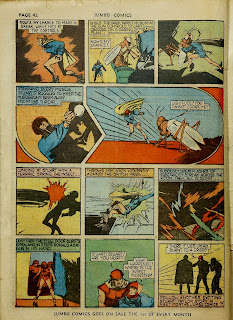
Not many days left in December to work on the ol' blog, but let's try to get through Silver Streak Comics #3, if nothing else.
This is the last page of Bill Wayne, the Texas Terror. Here he consistently shoots twice per turn, but I already discussed ways of accounting for that in the Hideouts & Hoodlums rules last time. This time, I want to point out the neck sheathe for a concealed knife -- and what an insanely dangerous place to store a knife that seems to be, to me.
Panel 5 is a clear example of simultaneous initiative.
Panel 5 is a clear example of simultaneous initiative.
Now we're going to look in on Lance Hale again, comics' only loincloth-clad interplanetary warrior.
That is one incredibly durable spaceship, since it is traveling faster than light when it crash lands. No one inside is even harmed!
Traveling faster than time transports you, not into the past or future, but into spirit-land here, which is a highly unusual twist. Spirit-land is inhabited by beast men (long ago presented as a playable race for 1st ed H&H in...one of the Trophy Case issues; I forget which one...).
How kind of the artist not to burden us with having to view that ferocious battle!
Here is some unusual evolutionary science: spiritmen have no bodies, but are somehow able to interact with Lance and grapple him. Having no souls puts them just below mankind "in the cycle of evolution." How did they evolve to have no souls or bodies?
As a reminder, Lance wears an armband that lets him operate as a superhero, wrecking things like chains (the door category) with ease.
That is a highly untraditional Crystal Ball, giving bodies to body-less beings instead of scrying.
Or is the Crystal Ball only an illusion generator? King Loti is revealed as a beastman...or a kenku...or a type I demon?
Can spiritmen/beastmen turn invsible, or is King Loti a beastman magic-user?
And what manner of invisibility is this, that Lance can see him but Dr. Grey can't. This is not like the Invisibility spell, so it must be a special ability of spiritmen, one that gives a saving throw vs. spells to resist.
Here we have the age-old question that has always plagued D&D -- how to adjudicate disbelieving in illusions? It seems that Lance here gets a saving throw just by stating the intention to disbelieve, or to "use his own will power."
Here's a special rule that will keep players from attempting to disbelieve in illusions all willy-nilly: disbelieving in one is so draining that you are too weak too move -- essentially paralyzed -- for 1-4 turns afterwards.
A chair is soft cover, improving Lance's AC by 1 (which he desperately needs, since he's almost naked).
Dr. Grey is taking quite a chance on a scheme that doesn't make much sense. Why does he need a silver bowl to disbelieve in illusions? And what if the spiritmen weren't illusions? Or are spiritmen always illusions?
This is from the next feature, Ace Powers. Here we have a very rare complication from combat -- arm paralysis caused by taking damage. Now, we could make up a new rule that any head blow that doesn't cause unconscious has a chance of a different result, and we could even design a random table for that...but the paralyzed arm doesn't here really change the combat any, so it passes the smell test for flavor text to me.
Tying the Hero to a steam radiator seems a low-key deathtrap that I'm surprised we've never seen before. Since the steam has to build slowly, it could start as 1 point of heat damage in turn 1, 1-2 points in turn 2, and so on.
This is one of those strange instances in comic books where taking damage causes consciousness instead of unconsciousness. It runs counter-intuitive to how damage works in both H&H and, frankly, every game system I can think of.
Duplicate keys must be like a skeleton key.
(Scans courtesy of Comic Book Plus.)

































